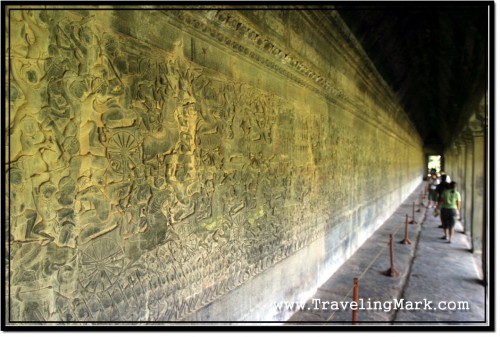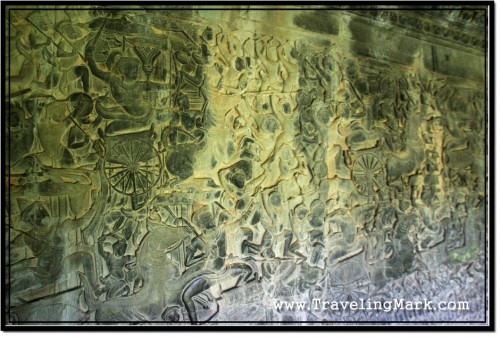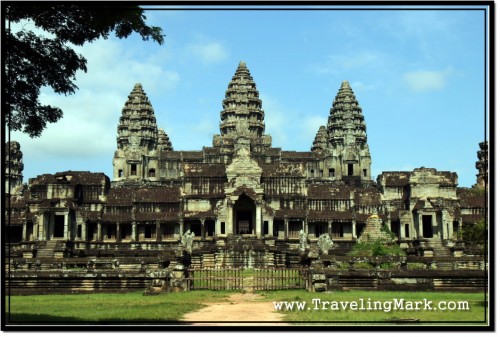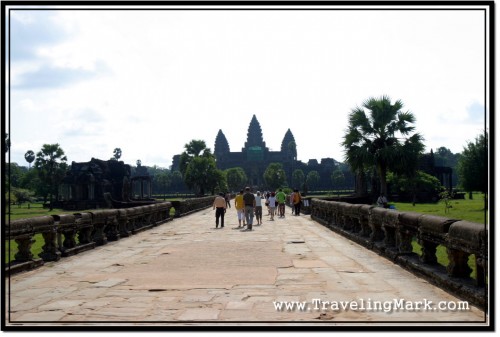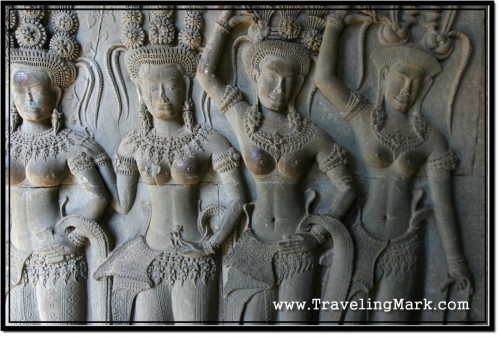Exploring Bayon is a challenging but rewarding experience. The temple is very complex both in terms of architecture and symbolism and offers many an opportunity to theorize on its structure and meaning. King Jayavarman VII who had the temple built had it altered several times but the modifications continued even after his death. It is believed that when originally built, Bayon had 49 face towers – towers adorned with giant faces each facing one cardinal point. Even after extensive restoration works, only 37 of Bayon’s towers are still standing. Let’s take a look at some of Bayon’s facts. This guide will be accompanied with pictures.
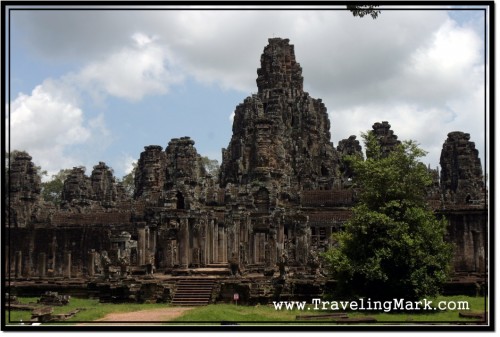
Just as is the case with most Angkor temples, Bayon faces east. I approached Bayon from the south after crossing the South Gate of Angkor Thom and turned right on the T intersection which got me on the road encircling the temple. Turning right took me to the main entrance in front of which I parked my bicycle (at the elephant station).
Broad, two-levelled terrace serving as an approach to Bayon is guarded by stone lions and naga serpent as balustrades on far sides. Despite extensive restoration works, much of the terrace is in desolate state but the feel of walking on ancient stones is much stronger than any other structure at Angkor. The sun was frying me alive and was far more intense now as it got closer to noon, than it was during my exploration of Angkor Wat.
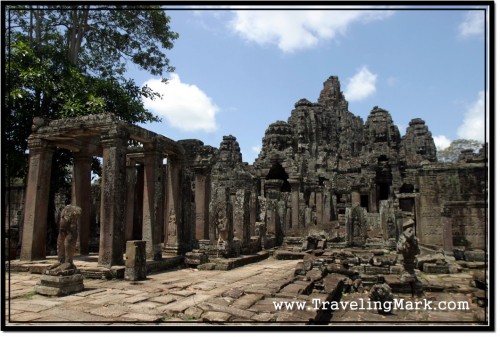
Entrance gopura (gate) consists mostly of collapsed stone frames serving as doors but there are no walls. Piles of giant stones lie scattered randomly around as archaeologists try to figure out which ones belong together so they can paste the whole temple together to its intended look.
Galleries within outer enclosure contain extensive carvings and bas reliefs. It comes as a striking contrast seeing fine work of artists who skilfully covered entire exterior wall with beautiful bas reliefs against the pile of disorganized, large rectangular stones laid piled up right opposite of it. Much work needs to be done to fully restore Bayon.
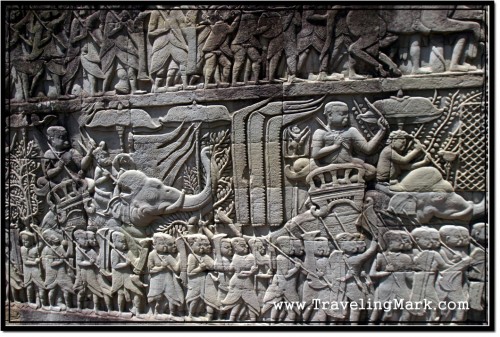
I turned left at the main entrance because the bas relief on this section of the outer wall seemed the most interesting. The carvings continue around the corner and throughout the south wall which has its own, collapsed gopura. There are several chapels within the exterior wall that can be entered as you’re exploring the bas reliefs. Because Bayon was a state temple, I think these chapels once house statues of divinities.
As I got within the outer enclosure, the face towers took more distinct shape. From the outside they appear as a disorganized pile of rocks sticking up. Countless hallways and wall-less corridors make navigation trickier as you get inside. Several flights of stairs are available to take to get to the second and third levels. Some are easy to climb, others downright dangerous, especially if you’re carrying a DSLR camera like I did.
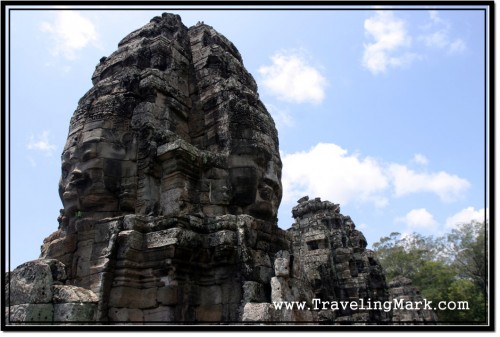
Because Bayon was remodelled so many times after taking its original shape, exploring the interior of the temple is a bit confusing. The temple is large to begin with but oddly structured galleries and terraces which were added later made it difficult to set out on an obviously best way to explore it all. The best way for me to describe it is by thinking of it as a maze without walls. You can exit any corridor through the wall that is not there and get to another corridor through the wall it doesn’t have. It’s literally akin to cheating in a videogame. You are an explorer of an ancient temple on a mission to find holy grail, but you hacked the game and can just take shortcuts.
The face towers are clearly the most attractive and photogenic (picture friendly) part of Bayon. Aside from crowning the entrance gates (gopuras), the face towers can also be found at corner angles but also as free-standing pillars on upper level. Because many of these towers were added later, they don’t seem to be placed in any logical order and just give an impression of being there to rise up to the sky.
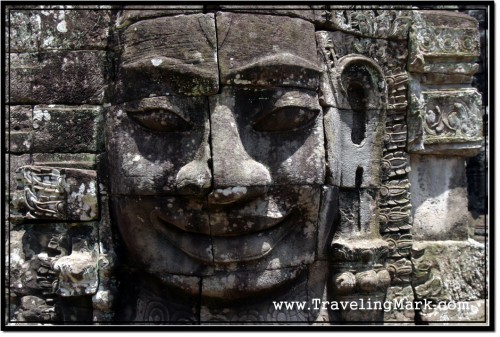
When I reached the upper terrace, I was offered several good opportunities to take pictures of the giant faces. The space on top seems more organized with fewer collapsed structures and it’s overall less tight (as far as breathing space is involved). From here you can get up close and personal with the free-standing face towers.
Historical inscriptions suggests that Jayavarman VIII, a rather insignificant Khmer king who took over the kingdom after Jayavarman VII has order a destruction of Buddhist symbols and initiated conversion to Hinduism. It was during his rule, when 3.6 meters tall statue of Buddha sitting on a body of a serpent whose multi-headed head shelters him was destroyed. Remarkably, all pieces of this statue, which was originally housed in the oval sanctuary at the heart of Bayon, were recovered enabling full restoration of the image. There are several smaller replicas of the same statue throughout Bayon, but the original, restored piece was relocated and is currently housed in Vihear Prampil Loveng – a small pavilion south of the Victory Way (road connecting Victory Gate with the Royal Palace area), next to South Khleang.
When you get to a sanctuary housing a statue of Buddha, there will likely be some locals inside as well. They sit and patiently wait inside with incense sticks at the ready and as soon as a foreigner enters the room, the sticks will be handed to them. It is a natural instinct of every person to take what is offered to them, especially if statue of a local divinity is present. This is exactly what these people are counting on because once you grab a hold of what is handed to you, they won’t be taking it back but will be insisting that you make a donation that as they claim, would go to the monks and to the preservation of the temple. None of the money provided will ever make it to any purpose other than personal enrichment of a person who gets the money from you. Just as almost everything else in Cambodia, this is a scam. The best way to protect yourself is to never ever impulsively take anything that is handed to you. No matter whether the person handing you stuff is a kid, or a nun with shaved head and robe draped around her body – the purpose is to abuse the presence of the divinity and scam you out of money. Don’t be surprised if you get told to “f%$k off” or called “stingy” or “a$$hole” by a kid whom you didn’t give any money. You may not see this anywhere else in the world, but in Cambodia, touts will not hesitate to call you names and swear straight in your face if they fail at scamming you of money.
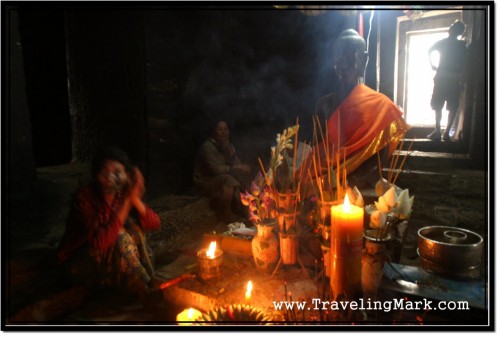
Once I got the layout of Bayon more or less figured out, I saw it as a structure consisting out of three main sections. Starting from top middle, there is an oval sanctuary that is the center of the temple originally assigned to house the large statue of Buddha which was later destroyed as described above. The oval sanctuary is surrounded by four corridors creating an orthodox cross around it. These serve as access points to the sanctuary with east entrance being the largest. This is the third, top tier of Bayon.
Second tier consists of rectangular inner galleries (second enclosure) encircling the orthodox cross with the circular sanctuary in the middle of it. First tier consists of outer galleries (exterior enclosure). Passages at each cardinal point connect outer galleries with the inner ones.
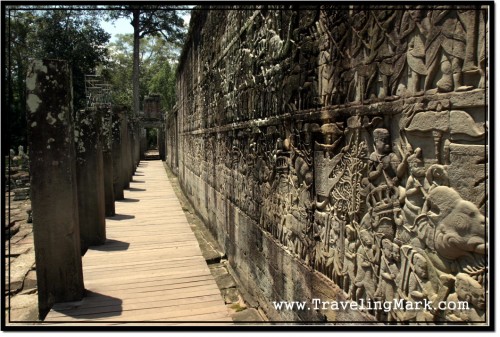
Bayon is covered with extensive bas reliefs. Earlier carvings mostly contain scenes from every day life at Angkor Thom as well as the battles with Champa armies on the great lake whereas later carvings contain scenes from Hindu mythology, signifying the conversion of the religion during the reign of Jayavarman VIII.
Bayon was a temple honouring a host of gods which gave it the name of “Tevea Vinichay”, which loosely translates as “Assembly of the Gods”. Its principal sanctuary housed an image of Buddha, but dozens of other sanctuaries housed various provincial and local Khmer gods. Inscriptions on door jabs of these small sanctuaries tell us about the many gods housed by them during the reign of Jayavarman VII.
North East corner of Bayon has a small, stand alone gallery with many people inside. There was another such gallery at the south-east corner but because that part of Bayon is in much ruin, there was nobody there. I thought something interesting must surely be within the gallery given the number of people inside and around it so I went to take a climb. The access was extremely difficult as stone steps are high and steep, much steeper than I had seen anywhere before. To my disappointment, there was absolutely nothing inside. I think people were just hanging in there, killing time. Some interesting bas reliefs could be found on the outer wall of the gallery, otherwise nothing excessively special about it.
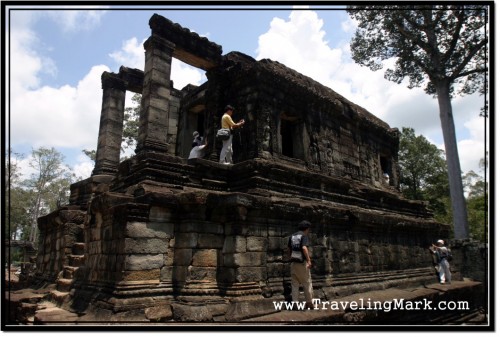
I spent several hours exploring Bayon. I started in late morning and wasn’t done until early afternoon. This basically means that I spent the hottest part of the day marking the ancient stones of the temple with my sweat. As I found out later, this was a great idea. Vast majority of organized tours take their high paying customers back to Siem Reap during noon hours so they can have lunch in one of the air-conditioned restaurants. The number of tourists at Angkor drops significantly during that time. As such, it is advisable for solo explorers to brave the midday heat and continue exploring the temples during lunch hours despite intense sun.
Because Bayon is the second most famous temple of Angkor (second only to Angkor Wat) and is a must-see for everyone coming to Angkor Archaeological Park, there were a few dozen people sharing the temple with me despite scorching midday sun. However it is better to have to share it with a few dozen people, than with hundreds, who on top of it all have an escort with an umbrella to shelter them from the sun and oftentimes a guide as well.
The best time to visit Bayon would be either very early in the morning (when all organized tours are at Angkor Wat), during noon (when all organized tours are back in Siem Reap for lunch) or in late afternoon (after 4pm, when all organized tours are either in Banteay Srei or already lining people up to go on Phnom Bakheng to watch sunset from the hill). The worst time of the day would be between 8am and 10.30am when dozens of buses full of rich tourists park it next to the temple and release hundreds of people to swarm the temple, turning it into an anthill full of crawling creatures.
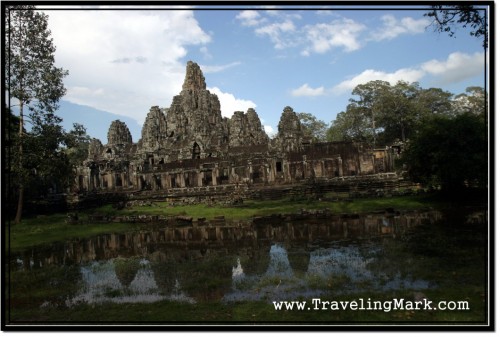
Even though already completely devastated from exposure to extreme sun, after I was done exploring Bayon, I was still determined to complete the small circuit the same day. I was done with two of the largest structures to explore, but many more to go. Angkor Thom itself had several more iconic pieces nearby. I made an attempt to stop at one of the food stalls north west of the temple but touts were so aggressive, I opted for a swift dart off. The temple of Baphuon, which is 200 years older than Bayon was next.
